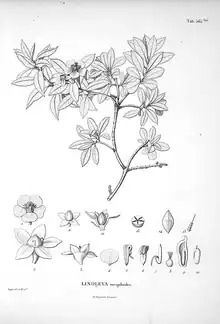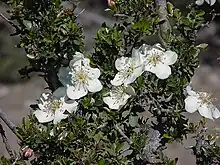Lindleya
Lindleya is a genus of Mexican evergreen trees of the family Rosaceae. The sole species, L. mespiloides, grows to a height of 6 metres (20 ft) and bears solitary white fragrant flowers in summer. The fruit are dry dehiscent capsules.[2]
| Lindleya | |
|---|---|
 | |
| Lindleya mespiloides Illustration by Pierre Jean François Turpin from Kunth, Bonpland, and Humboldt's Nova genera et species plantarum (1815–1825) | |
| Scientific classification | |
| Kingdom: | |
| (unranked): | |
| (unranked): | |
| (unranked): | |
| Order: | |
| Family: | |
| Subfamily: | |
| Tribe: | |
| Genus: | Lindleya Knuth |
| Species: | L. mespiloides |
| Binomial name | |
| Lindleya mespiloides H.B. & K. | |
Taxonomic history

Lindleya, along with Vauquelinia and Kageneckia were formerly placed in family Quillajaceae. It shares a base chromosome number of 17 with the pome-fruited members of tribe Maleae within the Rosaceae.[3]
Notes
Wikimedia Commons has media related to Lindleya.
- Potter, D., et al. (2007). Phylogeny and classification of Rosaceae. Plant Systematics and Evolution. 266(1–2): 5–43. [Referring to the subfamily by the name "Spiraeoideae"]
- Evans, R.C.; Campbell, C.S. (2002). "The origin of the apple subfamily (Rosaceae: Maloideae) is clarified by DNA sequence data from duplicated GBSSI Genes" (PDF). American Journal of Botany. 89 (9): 1478–1484. doi:10.3732/ajb.89.9.1478. PMID 21665749.
- Campbell, C.S.; Evans, R.C.; Morgan, D.R.; Dickinson, T.A.; Arsenault, M.P. (2007). "Phylogeny of subtribe Pyrinae (formerly the Maloideae, Rosaceae): Limited resolution of a complex evolutionary history" (PDF). Plant Systematics and Evolution. 266 (1–2): 119–145. CiteSeerX 10.1.1.453.8954. doi:10.1007/s00606-007-0545-y. S2CID 13639534.
This article is issued from Wikipedia. The text is licensed under Creative Commons - Attribution - Sharealike. Additional terms may apply for the media files.